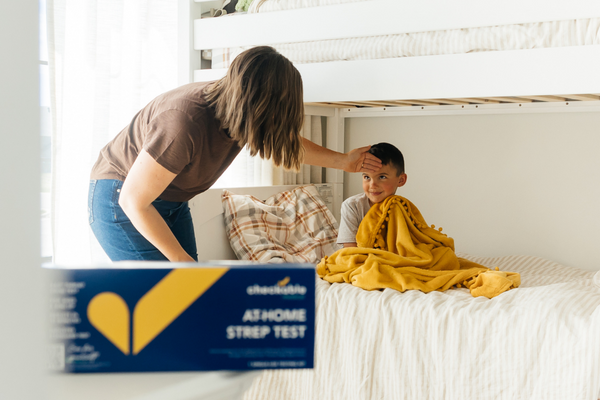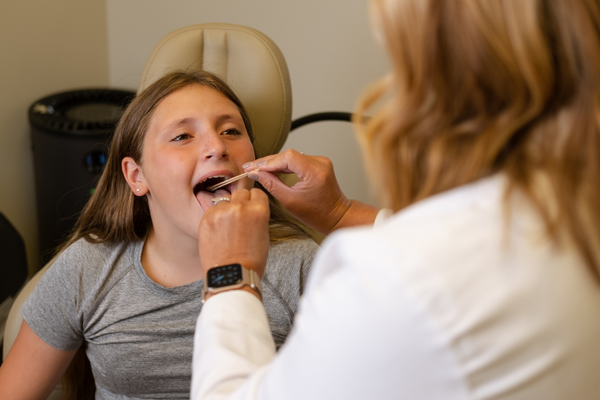
It’s that time of year again, back to school — and back to germs.
Colds, allergies, and strep, oh my!
As moms, you’ve probably seen it all.
But no matter how old your kids are, every parent can attest to feeling helpless when their kids are sick. So, if your little ones complain of a sore throat, the “not knowing” if it’s strep or simply a sore throat can be extremely frustrating. Especially if you’re dealing with something as highly contagious as strep.
Although the most common cause of a sore throat is a virus, like the flu or the common cold, about 1/3 of all sore throat illnesses in children are actually bacterial. And many parents unknowingly treat the wrong illness because they want to be proactive in getting their kids feeling better. However, even though symptoms can look the same, diagnosis and treatments are different.
So, wouldn’t it be nice to know right off the bat if you’re dealing with strep?
Fortunately, there are easy ways to recognize the strep throat symptoms to get your little (or big) ones treated quickly.
What Exactly Is Strep Throat?
Strep throat is an infection caused by group A streptococcus bacteria found in the back of the throat and on the tonsils. According to the Mayo Clinic, strep throat is most common in school-age kids and teens between 5 to 15 years old; although anyone can get it, even babies. And strep cases tend to rise during the school year (typically in winter/early spring) when kids are indoors more and in close quarters.
Strep throat is highly contagious and spreads quickly. It can be passed to others for up to three weeks and is usually transmitted through coughing or sneezing, but kids (and adults) can also catch it by touching a contaminated surface — like a toy, cell phone, or a doorknob. You can also get strep from sharing food or drinks with an infected person.
Strep throat symptoms are very similar to viral infections, so the only way to know for sure if it is strep is to take an at-home rapid strep test (or at the doctor’s office).
Even though strep is generally easily treatable with antibiotics, if left untreated, it could lead to some severe complications, including scarlet fever or rheumatic fever.
Start by looking at your kid’s throat for a few tell-tale signs that can point you in the right direction.

What to Look For: Signs & Symptoms of Strep Throat
If your child is sick and able to express what is hurting them, you may be able to recognize symptoms of strep easily. Of course, if your child is under 3, it may be tough to identify. Not all kids will have these symptoms. About 20% of school-aged children may carry the bacteria but show no symptoms.
Strep throat in kids over 3:
Preschool and school-aged kids tend to show classic signs of strep throat including:
- A very sore throat that comes on quickly
- Pain while swallowing
- Fever
- Tonsils that are red, swollen, and covered with white dots (pus)
- Scarlet fever (a red, sandpaper-like rash that can develop alongside strep)
- Swollen glands (lymph nodes)
- Headache
- Tired/fatigue
- Loss of appetite (hurts to eat)
- Nausea or vomiting
Signs that DO NOT usually come with strep throat are:
- Cough
- Runny nose
- Hoarseness
- Conjunctivitis (pink eye)
Babies and toddlers may also experience unexplained crankiness, loss of appetite, and laryngitis when they have strep.

Treatment for Strep Throat
If your child shows signs of strep, a rapid strep test (simple swab) will detect if there are antigens (indicators) belonging to the bacterial strain Streptococcus A. Results come in under 10 minutes.
If your child tests positive, most strep cases require antibiotics which will have your child feeling better in just a few days.
Be sure to keep them home from school until they have been on antibiotics for at least 24 hours.
Use over-the-counter pain medications like Advil or Tylenol can help bring fever down.
And aside from meds, there are some things that you can do at home to help your kiddos feel a bit more comfortable.
The best thing to do is make sure your sick child gets plenty of rest and extra fluids (water or apple juice) to avoid dehydration. Warm liquids like hot chocolate or mom’s chicken soup will also do the trick. Also, offer liquids like water, apple juice, or soup (avoid acidic juices like orange or grapefruit, which can irritate the throat) and cold or soft foods like popsicles, yogurt, or cottage cheese.
Use cough drops, lozenges, or numbing spray can soothe irritated throat and use a cool-mist humidifier (moist air may help ease a dry throat.)
Also, make sure they’re getting enough rest.
When your child is fever-free, feeling better, and has been on antibiotics for over 24 hours, they can return to school and regular activities.
Don’t forget, strep is very contagious so remind your kids to wash their hands frequently and not share cups and utensils to keep from spreading.
Calling All Moms: Does your child frequently get a sore throat? Learn more about Checkable’s at-home strep trial!

Would you like to be able to check for strep throat in the comfort of your home? Checkable Medical would love your help in doing this!
We have an exciting new clinical study that we are enrolling for starting this fall at Plains Medical Clinic in Fargo. This study help contribute to the development of an at-home strep test.
To be considered for the study, you must be 5 years of age or older and have two or more symptoms of strep throat (sore throat, fever, throat redness, swollen lymph nodes, and/or swollen tonsils with white patches).
Please note that there are a few other criteria needed to enroll, so please contact Plains Medical Clinic at 701-499-4800 when you or your child have strep symptoms to see if you qualify.
Participants who qualify for the study can expect to receive a test kit and instructions that will train the user on how to take a throat swab and interpret the results.
The actual study will include you taking a throat swab sample, performing a simple strep test, and then answering a short survey on your overall experience.
Upon completion of the study, participants will be compensated for their time.
Thank you for helping us advance diagnostic testing for strep!
You can get all the details here of how it works.
















